Best Practices for Writing Google Business Profile Descriptions (GBP) in 2025
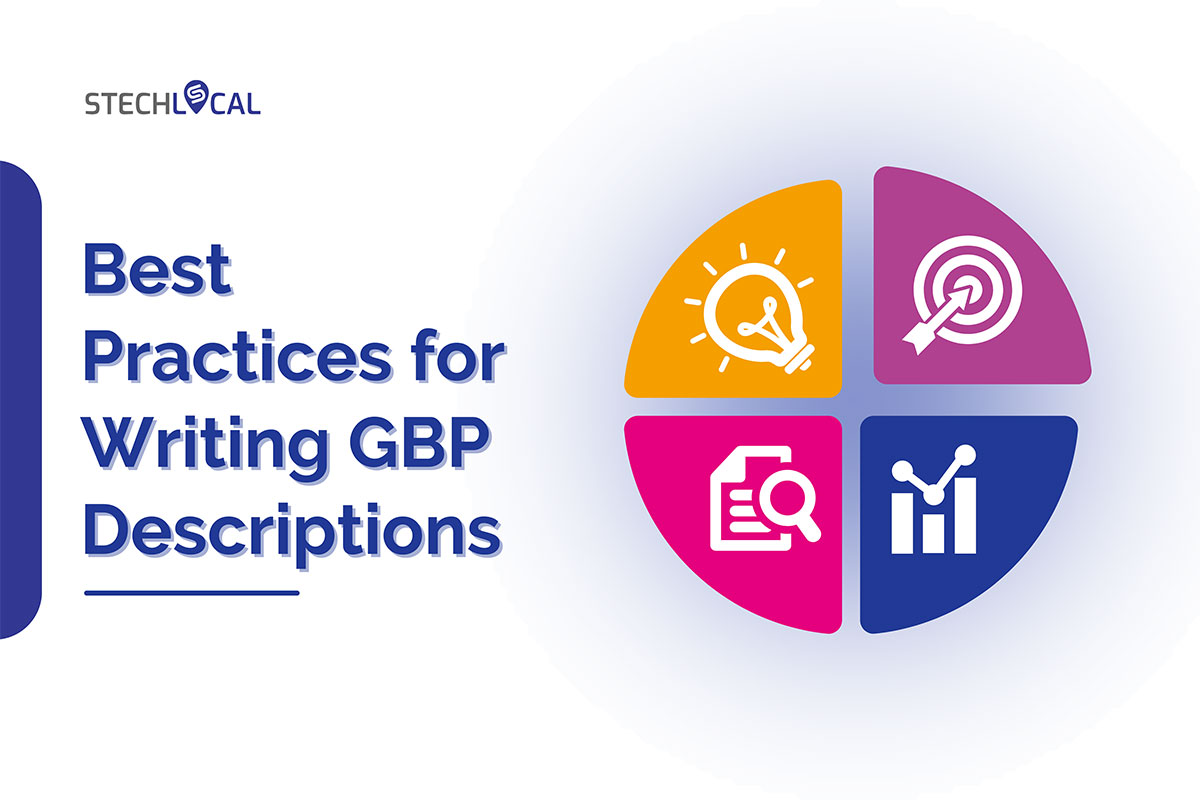
Your Google Business Profile (GBP) is one of the most powerful tools for boosting local visibility. Yet, many businesses overlook the importance of a well-written description—missing a key opportunity to stand out in local search.
When optimized properly, your GBP description can improve local SEO, engagement, and click-through rates, all while aligning with Google’s latest content guidelines.
Let’s walk you through everything you need to know about best practices for writing GBP descriptions effectively. From the key elements of a high-performing description to common mistakes to avoid, everything is under one roof.
What Is a Google Business Profile Description?
With 89% of consumers researching locally and 80% converting, every character in your GBP description counts.
A Google Business Profile description is a brief summary of your business that appears on your GBP listing in Google Search and Google Maps. It gives potential customers a quick snapshot of who you are, what you offer, and what makes your business unique—all within a limited space of 750 characters.
Unlike your business name, categories, or attributes, the description is one of the few places where you control the messaging. It’s your chance to communicate your unique value proposition, highlight your core services or products, and include location-relevant keywords to help boost visibility in local search results.
It’s important to note that the description doesn’t impact your primary business category or attributes directly, but it does influence relevance signals in Google’s local algorithm.
Moreover, it plays a key role in user experience by helping searchers quickly decide whether to engage with your business over a competitor’s.
Key Facts About GBP Descriptions:
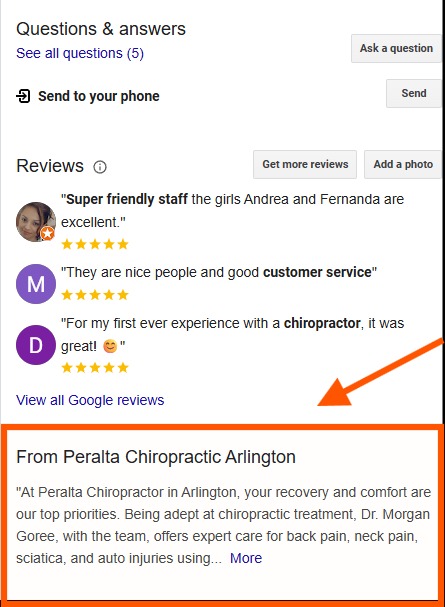
- Location: Displayed in the "From the Business" section of your GBP listing.
- Character Limit: Up to 750 characters (only ~250–300 show before truncation).
- Editable by: Business owners and managers via the Google Business dashboard.
- Content Guidelines: No promotional offers, no links, no offensive language, no spammy keywords.
Best Practices for Writing GBP Descriptions
Writing a strong Google Business Profile demands a strategic blend of Local SEO checklist principles, brand clarity, and natural language processing (NLP) best practices. Since Google’s algorithm has evolved to understand context and intent (thanks to models like BERT and MUM), keyword stuffing is no longer effective—in fact, it can harm your visibility.
Following are proven copywriting techniques that ensure your GBP description is optimized for local search and user engagement in 2025:
1. Use Primary and Semantic Keywords Naturally
Start by identifying the primary keyword for your business (e.g., “family law attorney in Chicago”) and support it with related semantic keywords (e.g., “child custody,” “divorce lawyer,” “legal consultation”).
Do this:
“We’re a Chicago-based family law firm specializing in custody, divorce, and mediation.”
Don’t do this:
“Chicago attorney Chicago divorce lawyer custody lawyer Chicago IL law firm.”
2. Prioritize Relevance Over Density
You don’t need to repeat keywords multiple times. Google is now context-aware—one well-placed keyword phrase can be enough if the rest of the content supports it. Avoid “keyword stacking” or awkward phrasing just to fit in a term.
3. Write Like a Human, Not a Bot
Modern SEO rewards natural, readable language. Write as if you’re explaining your business to a potential customer—not just to an algorithm.
Pro Tip: Read your description out loud. If it sounds robotic or forced, it needs revision.
4. Incorporate Entity-Based Language
Google uses entity recognition to associate businesses with related services, industries, and locations. Instead of repeating keywords, reference related concepts, like tools you use, customer types, certifications, or industries served.
Example: “We serve homeowners, property managers, and developers with eco-friendly HVAC systems.”
5. Optimize for the Truncated Preview (First 250 Characters)
Only the first 250–300 characters are visible before the “more” link is triggered in search results. Make this section clear, impactful, and informative—your best content should come first.
Strong opening example:
“Voted Seattle’s top-rated home remodeling company, we deliver custom kitchens, bathrooms, and full renovations with award-winning craftsmanship.”
6. Review and Update Regularly
Your GBP description should evolve with your business. New services, seasonal shifts, expanded locations, or brand repositioning should trigger a review. Updating it quarterly is a good practice.
Algorithm Alert: June 2025 Core Update
Google’s June 2025 core algorithm update, which started on June 30 and completed around July 17, shook up search results—over 16% of URLs ranking in the top 10 weren’t in the top 20 prior to the update.
This level of volatility highlights a critical truth: even small GBP elements, like your business description, can influence ranking stability and visibility. In a post-core-update world, fresh, relevant, and optimized GBP descriptions aren’t optional—they’re essential.
Why GBP Description Is Important for Local SEO
1. Supports Relevance in Google’s Local Algorithm
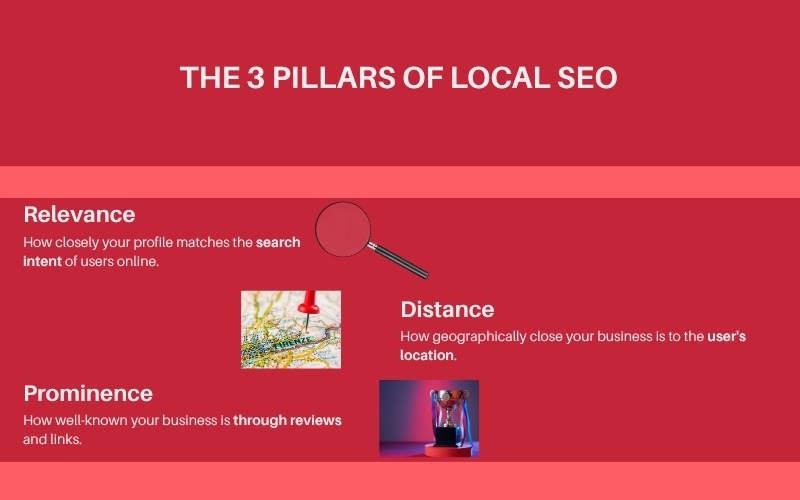
Google’s local ranking algorithm is based on three pillars: relevance, distance, and prominence.
A well-optimized GBP includes a well-structured description that strengthens the relevance signal by using naturally integrated keywords that reflect what your business does and the services you offer.
As Matt Hildon, Retail Director at Valtech, puts it:
“2025 is the year that search changed for the first time since the engines were invented.”
This shift highlights how critical it is for businesses to rethink even small elements of their online presence—like their GBP description. In a world of AI-powered results and smarter local intent detection, every word you publish matters more than ever.
For example, if you’re a “24-hour emergency plumber in Dallas,” including those terms in your description helps Google associate your profile with those searches.
2. Boosts Click-Through Rates (CTR)
In crowded local packs and map results, your description gives you a competitive edge. A clear, well-written description can instantly communicate credibility, professionalism, and local expertise—encouraging users to click your listing over others.
Businesses that fail to optimize this section often appear vague or untrustworthy, reducing the chance of engagement.
3. Provides Conversion Context
Beyond getting clicks, the description plays a subtle but important role in conversion. When a user lands on your profile, they’re often in decision mode.
Your description gives you a brief window to showcase what sets you apart—like “30 years of experience,” “locally owned and operated,” or “bilingual staff available.”
4. Influences Justifications in Search Results
In some cases, Google will pull text snippets—called justifications—from your GBP to show why your listing is relevant to a search. While these typically come from reviews, services, and attributes, a well-structured description with strong keyword context can be indexed and surfaced in these justifications.
5. Strengthens Brand Messaging
For multi-location businesses or agencies, the GBP description ensures that brand voice and key messaging stay consistent, even when listings are managed across multiple markets. This is crucial for both user trust and search engine clarity.
6. Boosts Local SEO Visibility
Google uses multiple signals to determine local rankings—relevance being one of the most important. A thoughtfully written GBP description reinforces what your business does and where it operates, helping Google better match your profile with local search queries.
Including key terms like your primary service, location, and niche (naturally!) can improve your chances of showing up in the Local Pack and on Google Maps.
7. Improves First Impressions
First impressions happen fast—and online, they happen in under a second. Your GBP description is one of the first pieces of content a user sees when they find your business in search.
A strong, professional, and informative description can build trust instantly and set you apart from competitors with generic or unoptimized listings.
8. Encourages Engagement and Action
While you can’t include links or calls to action in a GBP description, a well-phrased value message still nudges users toward the next step—whether that’s calling, requesting directions, or reading reviews.
A compelling description increases the likelihood of interaction, which can positively impact both user behavior and Google’s perception of your profile.
Official Guidelines: What Google Allows & What It Doesn’t
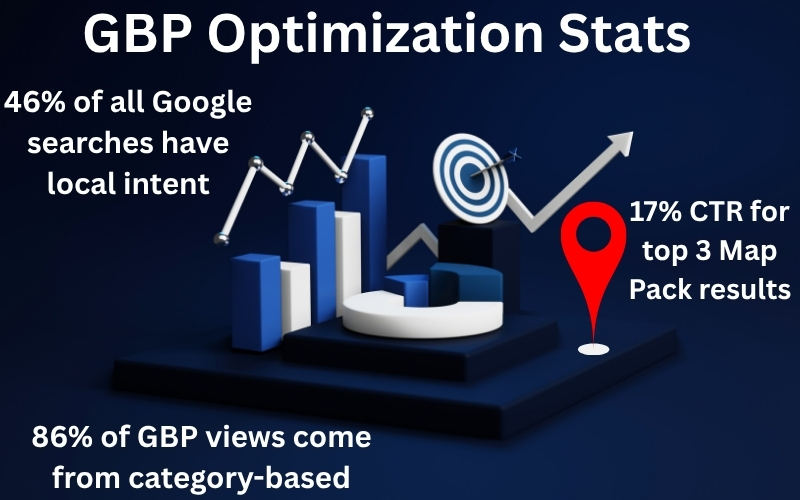
While the Google Business Profile description gives you creative control over how you present your business, it has limitations. Google enforces strict content guidelines, and violating them can lead to content rejection or worse, suspension of your profile.
To maintain compliance and ensure your GBP description helps rather than hurts your local SEO efforts, here’s what you need to know.
Real-time Update (2025):
Google recently introduced a new feature called “What’s Happening”, allowing restaurants and bars to showcase weekly specials, events, and updates directly within their Business Profile.
This shift highlights a growing trend—Google is prioritizing fresh, descriptive content that adds value for local searchers. A clear, relevant GBP description could improve how prominently your listing is displayed or enhanced in search.
What You Can Include in a GBP Description
Google encourages businesses to use the description field to provide helpful, truthful, and relevant information. Here’s what’s allowed—and recommended:
- Business Overview: Describe what your business does in simple, clear language.
Example: “We are a family-owned HVAC company serving the greater Denver area.”
- Core Services and Products: Mention your primary offerings using natural language.
Example: “Specializing in AC repair, furnace installation, and energy-efficient upgrades.”
- Unique Selling Propositions (USPs): Highlight what sets you apart.
Example: “24/7 emergency support and same-day service.”
- Years of Experience or Credentials: These help build trust.
Example: “Serving Chicago for over 20 years.”
- Target Audience or Locations Served: Adding this helps clarify your relevance to local searches.
Example: “Proudly serving homeowners in Los Angeles and Orange County.”
What You Can’t Include in a GBP Description
To preserve user trust and listing integrity, Google prohibits certain types of content. Violations can prevent your description from being published or may trigger a manual review.
- Links or URLs: You can’t include your website, booking page, or any clickable links.
Incorrect: “Visit us at www.bestdentist.com”
- Promotions, Offers, or Sales Language: Avoid advertising-style copy, including coupons, discounts, or calls to action like “Buy now.”
Incorrect: “Get 20% off when you call today!”
- Contact Information: No phone numbers, email addresses, or location-specific directions.
Incorrect: “Call us at (555) 555-1234”
- Offensive or Inappropriate Content: Google rejects content with hate speech, profanity, sexually explicit language, or personal attacks.
- Keyword Stuffing: Avoid repeating keywords unnaturally or stuffing location names to manipulate rankings. Google’s algorithm can detect and penalize this.
- All Caps, Emojis, or Excessive Symbols: These make your profile look unprofessional and violate formatting standards.
Incorrect: “🔥BEST PIZZA IN NYC��”
Pro Tips To Stay Compliant in GBP Description with Google Guidelines
- Keep your tone professional and informative, not promotional.
- Stick to facts, not hype or opinions.
- Avoid using language that mimics an ad or reads like a sales pitch.
- Write for clarity and trust, not just for rankings.
Key Elements of a High-Converting GBP Description
A high-performing Google Business Profile (GBP) description isn’t just compliant—it’s compelling. The best descriptions inform, differentiate, and persuade, all within Google’s 750-character limit. To achieve this, your content must be concise yet strategic, combining strong messaging with SEO-friendly structure.
The following are the essential elements that make a GBP description stand out and drive conversions:
1. Clear Unique Selling Proposition (USP)
Start with what makes your business different. Whether it’s your experience, service quality, specialty, or availability—lead with the hook.
Example: “Veteran-owned auto repair shop known for same-day service and honest pricing.”
2. Location-Specific Context
Mention your city, region, or service area naturally in your copy to improve local relevance.
Example: “Serving the Austin metro area for over 15 years.”
Don’t list multiple cities just for SEO—Google may flag this as keyword stuffing.
3. Core Services or Products
Briefly describe what you offer using language your customers actually search for. Focus on your top services rather than everything.
Example: “We specialize in residential roofing, storm damage repair, and insurance claims.”
4. Keyword Integration (Natural, Not Forced)
Use primary service-related keywords naturally—Google rewards relevance, not repetition.
Correct: “Licensed personal injury attorney helping accident victims in Dallas.”
Incorrect: “Dallas accident lawyer Dallas personal injury Dallas lawyer Dallas TX.”
5. Tone of Voice: Professional and Trustworthy
Write in a voice that reflects your brand—whether it’s formal, warm, or local-friendly. Avoid overly promotional or salesy language.
Example: “Locally trusted dentist offering compassionate care and advanced treatments.”
6. Social Proof or Credibility Markers
When possible, include trust-building phrases like years in business, awards, or affiliations.
Example: “BBB-accredited business with over 300 five-star reviews.”
7. Soft Call to Action (Optional but Powerful)
While explicit CTAs (“Call now!” or “Book today!”) are prohibited, subtle encouragement is allowed.
Example: “Reach out to learn how we can help with your family’s legal needs.”
8. Readability and Formatting
Avoid blocks of text. Use sentence case, simple punctuation, and straightforward language. The content should be skimmable even if it’s truncated in the search view.
GBP Description Examples (Good vs Bad)
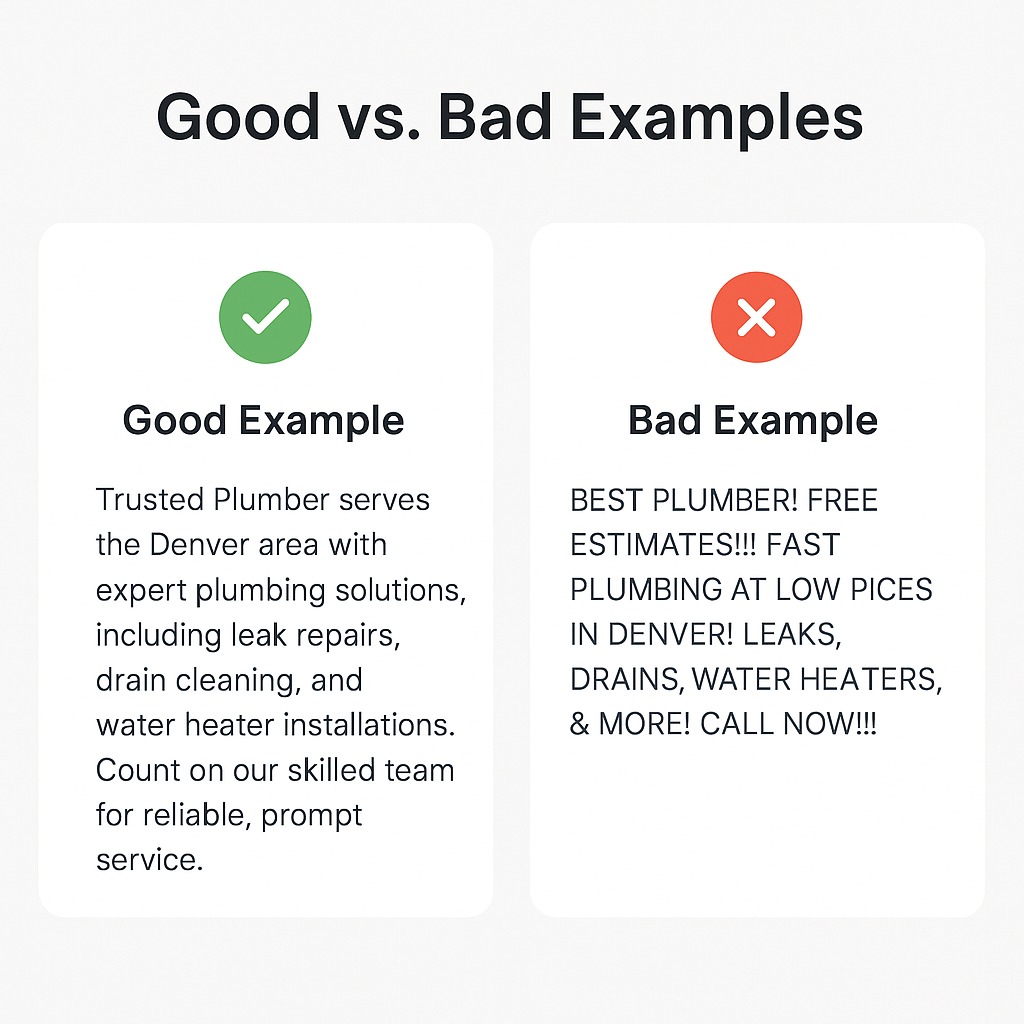
The following are examples of well-crafted vs poorly-written GBP descriptions across different industries, so you can clearly identify what works, what doesn’t, and how to elevate your own listing.
Example 1: Local Service Business (Plumber)
Good Description:
“Licensed and insured plumber serving Houston homes and businesses since 2008. We specialize in water heater repairs, drain cleaning, and emergency plumbing services. Trusted by over 5,000 customers across Harris County.”
Why it works:
- Includes USP (“licensed and insured,” “since 2008”)
- Lists high-intent services naturally
- Uses local keywords (Houston, Harris County)
- Sounds human, not salesy
Bad Description:
“Best plumber Houston plumber cheap plumber drain fix water heater Houston TX call now!”
Why it fails:
- Keyword stuffing
- Repetitive, unnatural language
- Violates Google’s guidelines (promotional tone, call to action)
- Reduces trust and readability
Example 2: Professional Service (Law Firm)
Good Description:
“Experienced personal injury attorneys in Dallas helping accident victims recover maximum compensation. We offer free consultations and have recovered millions in verdicts and settlements since 2005.”
Why it works:
- Establishes credibility and experience
- Mentions target location and service
- Includes trust-building facts
- Compliant with Google policies (no links or ads)
Bad Description:
“#1 Dallas lawyer! WIN your case now! Free call, fast results! Visit bestpersonalinjuryattorney.com today!”
Why it fails:
- Violates guidelines (URL, CTA, promotional hype)
- Aggressive tone reduces professionalism
- Keyword overuse and unnatural phrasing
Example 3: Retail or E-Commerce Store
Good Description:
“Locally owned boutique offering eco-friendly fashion and handmade accessories in Portland, Oregon. Visit us for sustainable clothing options and one-of-a-kind gifts crafted by local artists.”
Why it works:
- Highlights niche positioning (eco-friendly, handmade)
- Clearly describes what’s sold
- Includes geo-specific context
- Invites interest without being salesy
Bad Description:
“Buy now! Great deals on Portland clothes! Fashion sale – limited stock, best prices guaranteed!”
Why it fails:
- Salesy language violates Google’s description rules
- Doesn’t describe the actual business
- Lacks brand tone, purpose, or trust signals
Example 4: Healthcare Provider (Dental Clinic)
Good Description:
“Compassionate dental care for families in Phoenix. We offer preventative, cosmetic, and emergency dentistry in a friendly, bilingual environment. Accepting most insurance plans.”
Why it works:
- Communicates values + services
- Specifies target audience (families)
- Reflects an inclusive, trust-building tone
- Aligned with patient search behavior
Bad Description:
“#1 Dentist Phoenix AZ 🦷 Cheap dental work fast now walk-ins welcome hurry!”
Why it fails:
- Unprofessional tone + emoji misuse
- Non-compliant: promotional, exaggerated claims
- Doesn’t reflect brand quality or patient care standards
Common Mistakes to Avoid in GBP Descriptions
1. Avoid Keyword Stuffing
What it is: Repeating the same keywords or locations unnaturally to manipulate rankings.
Why it’s bad: Google’s NLP algorithms can detect over-optimization. Keyword stuffing not only hurts rankings, but it also makes your content unreadable.
2. Don’t Use Promotional or Salesy Language
What it is: Including offers, discounts, or CTAs like “Call now,” “Limited offer,” or “Best in town.”
Why it’s bad: This violates Google’s content guidelines and may lead to the description being removed or suppressed.
Bad Example:
“50% OFF! Visit us today! Call now for your free quote!”
3. Don’t Add Contact Information or URLs
What it is: Including your phone number, website link, or physical address.
Why it’s bad: Google already displays this information separately. Duplicating it in the description is redundant and non-compliant.
Bad Example:
“Visit www.johndoeheating.com or call (555) 123-4567 for details.”
4. Avoid writing for Bots, Not Humans
What it is: Prioritizing SEO tricks over readability.
Why it’s bad: Google’s BERT and MUM models prioritize user-focused language. If it sounds robotic, it will be penalized—and users won’t convert.
Bad Example:
“Lawyer injury claim best attorney Los Angeles injury lawyer attorney claim.”
5. Don’t Use Generic, Vague, or Copied Content
What it is: Using a basic or duplicated description across locations or profiles.
Why it’s bad: It fails to differentiate your business or trigger location-specific relevance. Duplicate content across listings may also be filtered or ignored.
Bad Example:
“We provide great service. Customer satisfaction is our goal.”
6. Don’t Ignore Truncation Rules
What it is: Burying your most important value points near the end of the 750-character limit.
Why it’s bad: Only ~250–300 characters are visible in search results. If your hook is hidden, users may never read it.
7. Don’t Fail To Update Descriptions Over Time
What it is: Leaving outdated or irrelevant content in your GBP description.
Why it’s bad: It misleads users and can damage your brand’s credibility. Businesses evolve—so should your profile.
Tips for Writing GBP Description for Multi-Location Businesses
If your business operates in more than one location—or you manage listings for multiple clients—writing GBP descriptions becomes more complex. The following are essential tips to help multi-location businesses write effective, scalable, and compliant GBP descriptions:
1. Use a Base Template with Localized Inserts
Create a core description template that reflects your brand’s identity and offerings, then customize it for each location by inserting local keywords, neighborhoods, and services.
Example Template:
“[Brand Name] is a trusted [industry/service] provider in [City/Region], offering [Key Services] backed by [Years] of experience and exceptional local service.”
2. Include Location-Specific Services or Differentiators
Avoid generic copy-paste descriptions across all listings. Instead, highlight what makes each location unique, such as service availability, specialties, or languages spoken.
Example:
“Our Miami location offers bilingual support and same-day AC repair services for coastal homes.”
3. Avoid Duplicate Content Penalties
Google discourages duplicate content across multiple listings. Even if your services are the same, tweak the tone, order, or structure for each description to ensure uniqueness.
4. Match the Local Intent and Search Behavior
Customers in different cities search differently. A customer in New York might search “emergency plumber NYC,” while someone in Phoenix may search “same-day leak repair.” Match local search intent by adjusting keyword strategy per region.
5. Stay Compliant Across the Board
What’s acceptable in one listing should be acceptable in all. Ensure your team follows the same guidelines—no phone numbers, links, or ads—across every profile. Google may apply penalties account-wide if one listing violates content policy.
Avoid “rogue edits” from local managers. Use centralized systems like Stech Local for access control and revision history.
Staying compliant isn’t just about visibility—it can directly impact your ability to run paid campaigns. In fact, Google now requires verified and policy-compliant GBP profiles to run Local Services Ads, making your description quality a paid ads issue too.
According to a report by AP News, small businesses risk ad disapproved if their profiles contain misleading, promotional, or non-compliant content.
6. Schedule Regular Reviews
Business details evolve—new services, seasonal offerings, awards, and service areas should reflect in your listings. For multi-location brands, set up quarterly audits to ensure all descriptions are up-to-date and aligned with your brand narrative.
Summary for Multi-Location GBP Strategy
| Do This | Avoid This |
| Use templates with location inserts | Copy-pasting identical content |
| Tailor services to local demand | Generic or vague descriptions |
| Rotate keywords by search behavior | Keyword stuffing or forced phrasing |
| Audit listings quarterly | “Set it and forget it” strategy |
Read Also: How To Optimize Google Business Profile
Summary
What Is a Google Business Profile Description?
A Google Business Profile description is a brief summary of your business that appears on your GBP listing in Google Search and Google Maps.
Best Practices for Writing GBP Descriptions
- Use Primary and Semantic Keywords Naturally
- Prioritize Relevance Over Density
- Write Like a Human, Not a Bot
- Incorporate Entity-Based Language
- Optimize for the Truncated Preview (First 250 Characters)
- Review and Update Regularly
Why the GBP Description Is Important for Local SEO
1. Supports Relevance in Google’s Local Algorithm
2. Boosts Click-Through Rates (CTR)
3. Provides Conversion Context
4. Influences Justifications in Search Results
5. Strengthens Brand Messaging
6. Boosts Local SEO Visibility
7. Improves First Impressions
8. Encourages Engagement and Action
Official Guidelines: What Google Allows & What It Doesn’t
Google enforces strict content guidelines, and violating them can lead to content rejection or worse, suspension of your profile.
- What You Can Include in a GBP Description
- What You Can’t Include in a GBP Description
Key Elements of a High-Converting GBP Description
- Clear Unique Selling Proposition (USP)
- Location-Specific Context
- Core Services or Products
- Keyword Integration (Natural, Not Forced)
- Tone of Voice: Professional and Trustworthy
- Social Proof or Credibility Markers
- Soft Call to Action (Optional but Powerful)
- Readability and Formatting
GBP Description Examples (Good vs Bad)
- Example 1: Local Service Business (Plumber)
- Example 2: Professional Service (Law Firm)
- Example 3: Retail or E-Commerce Store
- Example 4: Healthcare Provider (Dental Clinic)
Common Mistakes To Avoid in GBP Descriptions
- Avoid Keyword Stuffing
- Don’t Use Promotional or Salesy Language
- Don’t Add Contact Information or URLs
- Avoid writing for Bots, Not Humans
- Don’t Use Generic, Vague, or Copied Content
- Don’t Ignore Truncation Rules
- Don’t Fail To Update Descriptions Over Time
Tips for Writing GBP Description for Multi-Location Businesses
- Use a Base Template with Localized Inserts
- Include Location-Specific Services or Differentiators
- Avoid Duplicate Content Penalties
- Match the Local Intent and Search Behavior
- Stay Compliant Across the Board
- Schedule Regular Reviews
FAQs
What is a Google Business Profile (GBP) description?
A Google Business Profile description is a 750-character summary that appears in the “From the Business” section of your Google listing. It allows you to briefly explain what your business does, what makes it unique, and who it serves. This description appears in Google Search and Maps and helps customers quickly understand your business before they visit your website or location.
Why is a GBP description important in 2025?
In 2025, as local search competition increases, your GBP description plays a critical role in influencing both search visibility and customer decisions. It helps Google better understand your business offering and relevance, and it helps users decide if you meet their needs. A well-written description supports trust, boosts engagement, and contributes to higher click-through rates (CTR).
Does the GBP description affect SEO rankings?
Indirectly, yes. While the description isn’t a core ranking factor like reviews, categories, or proximity, it contributes to relevance signals in Google’s local algorithm. A description that includes natural, location-based keywords and clearly outlines your services can help improve discoverability in local search results and Google Map Packs.
Should I include my business location in the GBP description?
Yes—naturally including your service area or city helps Google associate your business with relevant local queries. However, avoid keyword stuffing or listing too many cities. Stick to your primary service area and mention it once in a contextual, user-friendly way.
How can I make my GBP description stand out?
To make your GBP description stand out, follow the following tips:
- Lead with your unique selling proposition (USP)
- Mention key services or specialties
- Highlight experience, awards, or trust signals
- Use a professional tone aligned with your brand voice
- Keep the most valuable content within the first 250 characters (as this shows before truncation)
How important are keywords in a GBP description?
Keywords are important—but they must be used strategically and naturally. Avoid repeating the same term multiple times. Instead, focus on your primary service-related keyword and support it with semantic alternatives. Google’s algorithm is smart enough to understand variations, so write with clarity, not keyword density.
Should I use my business category in the description?
Yes, but only if it fits naturally within your sentence. Google already categorizes your business, but mentioning your core category (e.g., “family law attorney,” “vegan bakery,” “roofing contractor”) once in the description reinforces topical relevance and helps users immediately understand what you do.
Can a bad GBP description hurt my profile?
Absolutely. A poorly written description that includes keyword stuffing, promotional language, phone numbers, or spammy content may be flagged or suppressed by Google. Worse, it can turn off potential customers and reduce your credibility. A weak or vague description is a missed opportunity to make a strong first impression.
How often should I review my GBP description?
You should review and update your description at least quarterly or whenever your services, service area, or branding changes. Keeping it current ensures accuracy, relevance, and alignment with search trends.
What are common mistakes to avoid in GBP descriptions?
Some of the most common and harmful mistakes include:
- Keyword stuffing
- Using promotional phrases (e.g., “Buy now,” “Best in town”)
- Including phone numbers or website links
- Copy-pasting the same text across multiple locations
- Writing vague or generic content
- Ignoring local context or customer needs

